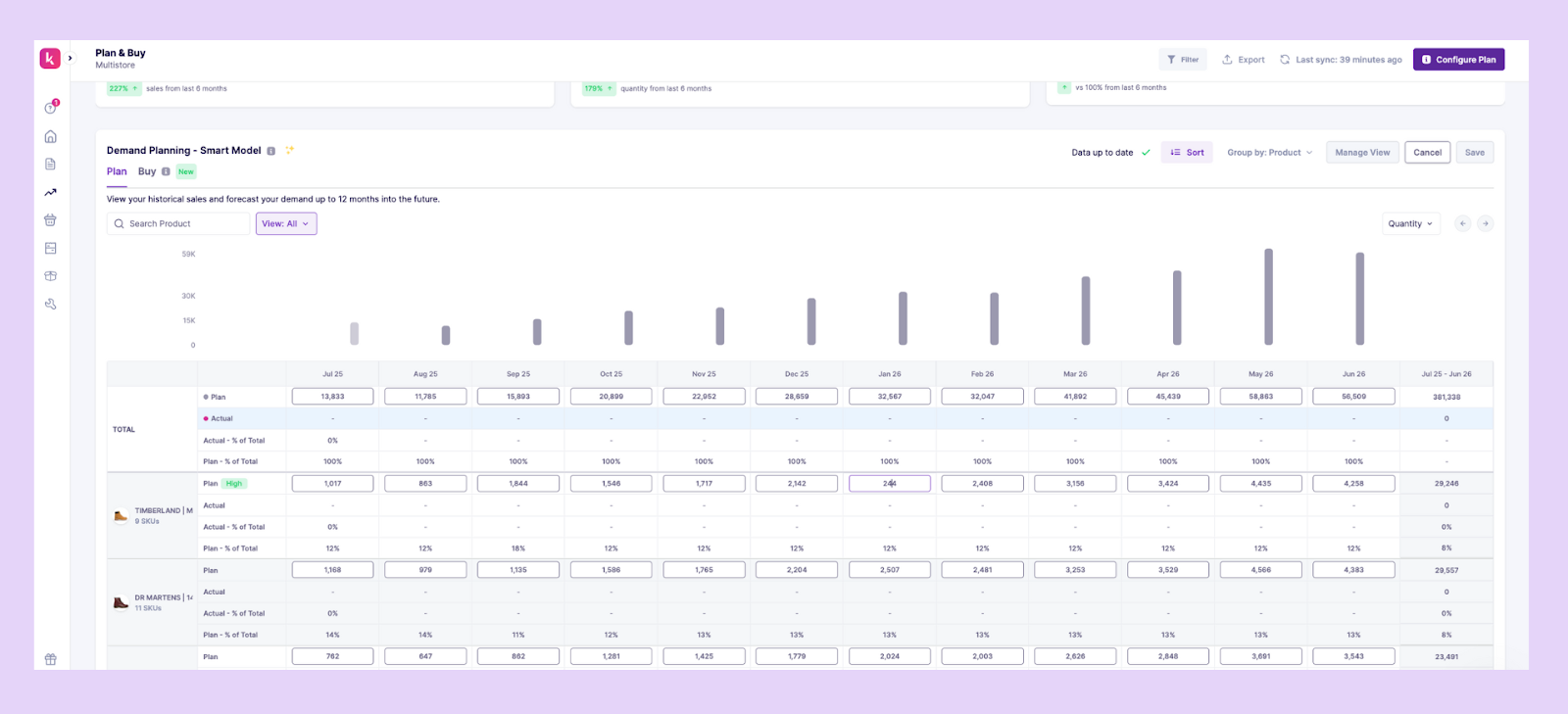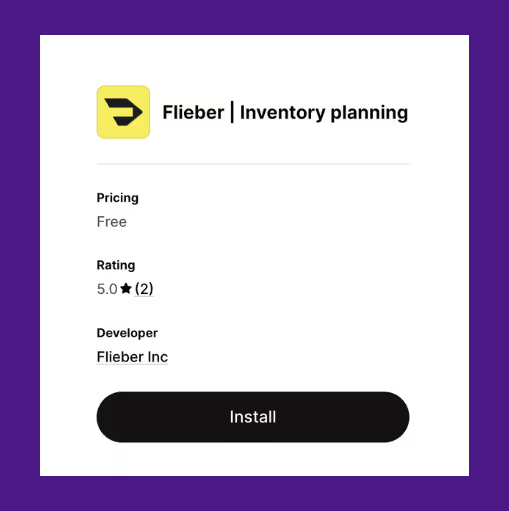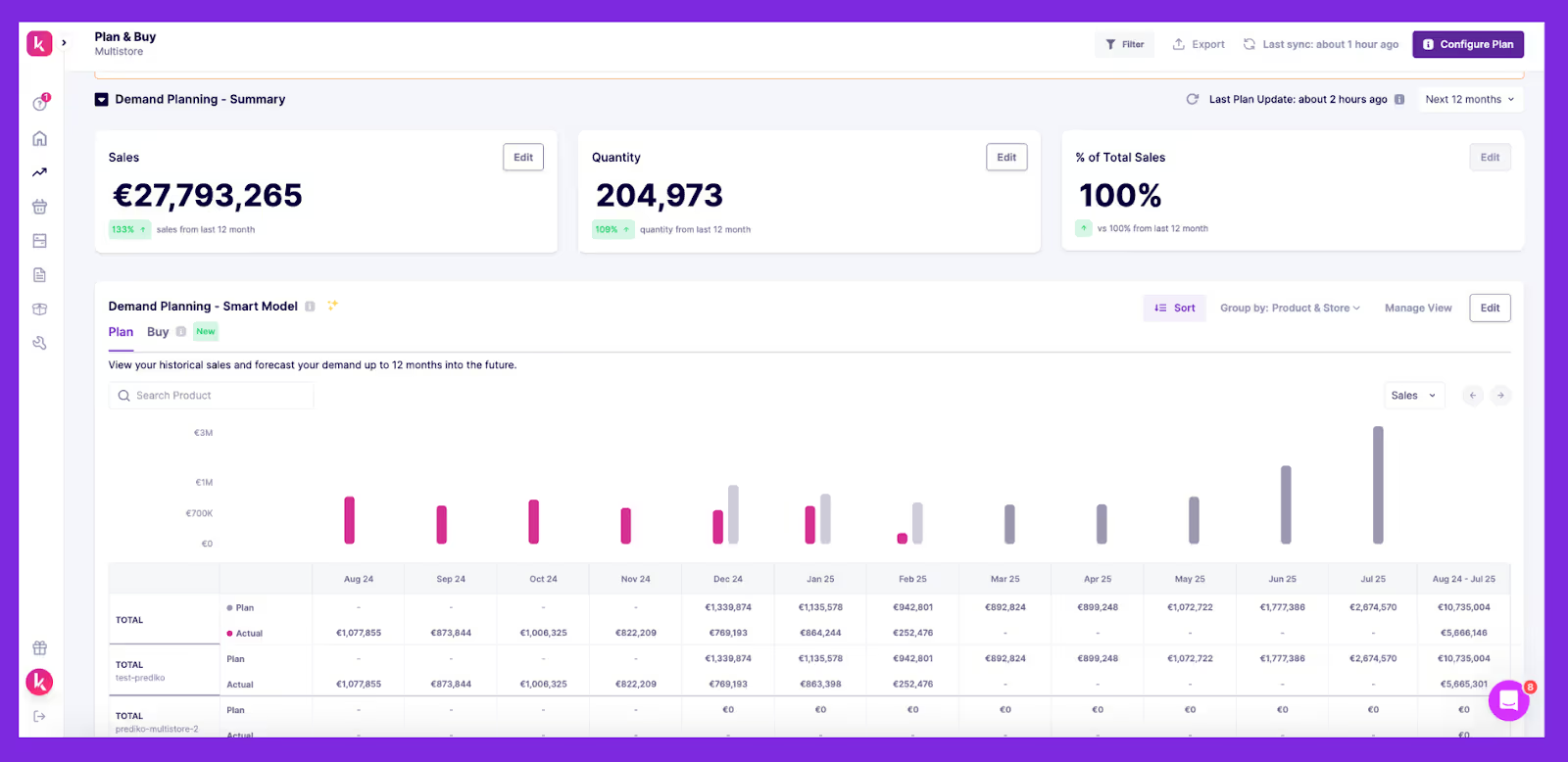Sales were steady…..until a bestseller disappeared from the shelves. Meanwhile, another region was drowning in the excess stock of that bestseller.
Inventory wasn’t the problem. Demand shifted, and no one saw it coming.
That’s demand variability.
It skews forecasts, ties up cash in the wrong SKUs, and leaves ops teams struggling to react. For Shopify brands managing dozens of SKUs across multiple warehouses, keeping inventory where it’s actually needed becomes a constant challenge.
We break it all down: what causes demand variability, how to measure it, and what you must do to stay ahead of it.
Understanding Demand Variability
Demand variability refers to the unpredictable fluctuations in product demand over time.
It’s the gap between what you forecasted and what customers actually purchased.
These swings can happen week-to-week, SKU-to-SKU, or region-to-region, making it harder to plan inventory accurately, avoid stockouts, or prevent overstocking.
High demand variability forces constant adjustments in purchasing decisions, reorder points, and safety stock levels.
If left unmanaged, it can disrupt cash flow, tie up working capital in slow-moving SKUs, and leave other products out of stock just when customers want them most.
Take gaming consoles as a demand variability example: sales might skyrocket during a big game release or holiday season, only to drop sharply once the hype fades.
Industries like fashion, electronics, food and beverage, beauty, and sports gear face this challenge regularly, as trends, seasons, viral moments, and major events make demand unpredictable.
The more volatile your market, the more you need smart demand planning tools that adjust to these shifts in real time.
Common Causes of Demand Variability
Most demand swings aren’t random. They’re triggered by known events or patterns. Here are some common causes of demand variability.
1. Seasonality
Many products see predictable spikes or dips in demand based on the time of year. Apparel sales peak during back-to-school or holiday seasons, ice cream demand rises in summer, and fitness equipment surges every New Year.
Seasonality makes demand cyclical, but unpredictable weather or shifting consumer behavior can still throw off forecasts.
Learn in-depth about forecasting seasonal demand.
2. Promotions and discounts
Flash sales, bundle offers, or clearance discounts can create sudden surges in demand.
While planned promotions may be forecasted, competitor-led discounts or last-minute marketing pushes often lead to unpredictable fluctuations in sales volumes.
Tip: Promotions temporarily inflate demand. Reset your forecasting models after the promo ends to avoid overordering based on artificial spikes.
3. Market trends and competitor activity
External factors can also impact your demand. Shifts in consumer preferences, viral social media moments, or a competitor’s new product launch can quickly change buying behavior.
These trends are hard to anticipate and can lead to sudden demand spikes or drops for specific SKUs.
For instance, if a competitor runs out of stock, you might see a temporary lift in sales, only for demand to drop once they restock, leaving you with excess inventory if you’ve already reordered.
4. Product launches and cannibalization
Introducing a new product can also generate unpredictable early demand, especially if it’s innovative or trend-driven.
At the same time, the new launches can pull customers away from existing SKUs, a phenomenon known as cannibalization, making it harder to forecast accurately for both the new and old products.
Challenges Posed by Demand Variability
Frequent shifts in demand often lead to the following business challenges.
1. Higher costs and slower supply chains
When demand is unpredictable, inventory levels swing between excess and shortage.
That leads to frequent stockouts, emergency replenishment orders, production overtime charges, and unnecessary holding costs.
Also, suppliers face unplanned order changes, production schedules are disrupted, and replenishment cycles become inconsistent.
Over time, this constant firefighting reduces supply chain efficiency and increases total landed cost per unit.
2. Planning gaps from inaccurate forecasts
When actual demand deviates sharply from projections, your purchasing, production, and inventory allocation plans quickly fall apart.
A forecast that’s off by even 20–30% for a high-volume SKU can throw off reorder timing, lead to wrong purchase quantities, and create mismatches between inventory and demand across locations.
This ripple effect can delay manufacturing runs, misallocate stock between channels, and erode efficiency in every planning cycle.
3. Missed orders and poor customer experience
High variability increases risk of stockouts on popular SKUs just when customers want them most.
When this happens, orders are delayed or canceled, forcing customers to wait longer or buy from competitors.
At same time, overstocking other products clogs storage and slows fulfillment. Both scenarios hurt service levels, reduce on-time delivery rates, and damage long-term customer trust and retention..
How to Calculate Demand Variability
Measuring demand variability is essential to understanding how unpredictable your sales patterns truly are.
There are several proven techniques to quantify these fluctuations and assess how much actual demand deviates from expectations.
Let’s look at some of the most common methods.
1. Standard deviation of demand
This is one of the most widely used metrics. It measures how much your daily, weekly, or monthly sales vary from the average demand for a product.
A higher standard deviation means greater unpredictability and a higher risk of stockouts or overstocking.
2. Coefficient of variation (CV)
CV is calculated by dividing the standard deviation by the mean demand. It’s expressed as a percentage and helps compare variability across different SKUs, even if their demand levels are very different.
For example, a CV of 10% indicates stable demand, whereas a CV of 80% signals high volatility.
3. Mean absolute deviation (MAD)
MAD tracks the average difference between your forecasted demand and actual sales.
It’s particularly useful for understanding how often and by how much forecasts miss the mark, helping you fine-tune safety stock levels.
4. Forecast error metrics (MAPE, Bias)
Metrics like Mean Absolute Percentage Error (MAPE) and Forecast Bias give you insight into how inaccurate forecasts have been historically.
A high MAPE signals inconsistent demand patterns, while persistent positive or negative bias indicates a systematic forecasting issue.
While these techniques give valuable insights, calculating demand variability is rarely straightforward. Multiple SKUs, changing lead times, promotional lifts, and external market factors make manual calculations complex and error-prone.
That’s why many fast-scaling eCommerce brands rely on advanced and AI-powered demand planning apps like Prediko that help spot patterns, quantify variability, and make smarter inventory decisions in real time.
Sync Protein, a fast-growing plant-based nutrition brand, struggled with unpredictable demand across eight product flavors due to manual forecasting in spreadsheets.
Using Prediko’s AI-driven platform, they gained real-time visibility into sales fluctuations, automated demand forecasting, and optimized reorder timing, saving 10 hours per week and reducing stockouts by 50%, even during periods of high demand variability.
Techniques for Dealing with Demand Variability
Demand variability is inevitable, but it doesn’t have to derail your operations.
With following methods for handling demand variability risks, manage unpredictability and make your supply chain more resilient.
Leveraging analytics in demand planning enables brands to detect shifts earlier, fine-tune safety stock, and align purchasing decisions with real-time demand trends — turning unpredictability into a competitive advantage.
1. Maintain safety stock to cover unpredictable demand
Safety stock is extra inventory held to prevent stockouts when demand exceeds forecasts or suppliers are late. It works only when maintained using data.
This technique is most effective when you calculate safety stock per SKU based on demand variability and lead time fluctuations. Applying the same buffer across all products leads to either overstock or missed sales.
Review safety stock monthly or quarterly, depending on the demand variability. Adjust ahead of peak periods using recent sell-through and supplier lead times.
Prediko is designed to handle demand variability, allowing you to set the number of safety stock days per SKU that you’d want to maintain.
It then generates smart reorder suggestions based on these inputs, helping you stay in stock without over-purchasing.

2. Use demand-driven planning to make faster decisions
Relying solely on historical averages often leaves you reacting too late when demand changes. A demand-driven approach uses live sales data to adjust forecasts and purchasing decisions instantly, reducing the risk of overordering or stockouts.
With Prediko, recommendations are based on your current sales velocity. If demand spikes, the system updates quickly and provides frequent, data-backed reorder suggestions, helping you react fast and stay in stock without overbuying.
3. Do scenario planning to prepare for demand shifts
Scenario planning allows you to test different demand outcomes before they happen, so you can adjust purchase plans, safety stock, or transfers in advance, rather than waiting for problems to appear in your numbers.
It’s especially useful when running promotions, launching new products, or facing potential supplier delays. Most teams model best-case, expected, and worst-case scenarios, each with its own reorder plan, safety buffer, and supplier strategy.
This approach lowers risk while avoiding unnecessary inventory buildup.
With Prediko, you can easily edit forecasts and instantly see how changes in demand numbers impact purchasing plans, helping you stay prepared for any situation.

4. Automate replenishment to respond faster
Manual reordering often leaves a time gap between when stock runs low and when action is taken. By the time someone notices, you’re already at risk of a stockout.
Automated replenishment bridges that gap by using reorder points, stock cover, or demand triggers to suggest purchases instantly, without waiting for manual checks.
It’s especially valuable when you’re managing a large catalog, losing sales due to slow responses, or spending hours on routine ordering tasks.
With Prediko, replenishment is automated through live PO recommendations based on sell-through, days of cover, and lead times.
You can quickly review suggestions, adjust quantities if needed, and create a purchase order with one click, keeping your reordering process fast, consistent, and stockouts under control.

5. Transfer inventory across locations to rebalance stock
When demand shifts unevenly, some locations may run out of stock while others sit on surplus inventory.
Instead of placing new purchase orders, moving stock between warehouses or stores helps you stay covered without overstocking every location.
This approach works best when you can quickly identify where excess aligns with shortages or when centralized fulfillment leads to long delivery times.
Internal inventory transfers are often faster and cheaper than waiting for supplier restocks, minimizing lost sales while optimizing overall stock levels.
With Prediko, you can create and manage inventory transfers directly between Shopify locations without switching platforms. This lets you respond faster to demand shifts while keeping inventory costs under control.

Software and Tools for Demand Variability Management
To make things simpler, we’ve shortlisted 5 Shopify apps that help you manage demand variability more efficiently, accurately, and with less manual effort.
1. Prediko

Prediko is the #1 AI-powered inventory platform for Shopify brands that helps plan, buy, and manage inventory across their supply chain. Its AI algorithm creates demand plans based on seasonality, past sales, and growth trends..
Forecasts are editable, so teams can update plans based on promotions or shifts in demand. Actual sales are tracked against the plan, making it easier to spot gaps early.
Prediko helps manage demand variability by tying forecast changes directly to replenishment.
The system flags at-risk SKUs, recommends quantities, and lets you create POs in one click. It also forecasts raw material requirements based on your finished goods demand plan, ensuring every part of your supply chain stays on track.
Key features
- Multi-location real-time sync: Track inventory across Shopify, POS, and warehouses instantly, making it easier to allocate stock when demand shifts
- AI demand planning: AI trained on 25M+ SKUs across 15 industries generates the demand plan, adapting to seasonal and trend-based variability
- AI supply planning: Get a complete buying plan with PO recommendations that adjust dynamically as demand changes
- Raw material management: Track, manage, and forecast raw material requirements based on changes in finished goods demand
- PO management: Create POs directly from your buying plan, then track and share them with suppliers from within Prediko
- Reports and analytics: Access 20+ fully customizable reports to analyze demand changes and prepare more accurately for future forecasts
2. Cogsy

Cogsy is a demand planning tool that helps Shopify brands respond to changing demand. It uses live sales and inventory data to recalculate forecasts and update purchasing plans.
This makes it easier to keep inventory aligned when sales spike or slow down.
Key features
- 12-month demand forecasting + actionable 60‑day SKU plans for purchasing
- Automatic forecast updates as new sales and inventory data arrive
- “What‑if” scenario planning for best, base, and worst‑case demand paths
- Fast PO generation with restock recommendations inline
- Backorder management to avoid lost sales during demand spikes
If you're looking for more flexible or execution-ready planning tools, this curated list of cogsy alternatives offers modern options tailored for fast-growing Shopify brands.
3. Flieber

Flieber is a demand planning platform that connects sales, inventory, and supplier data to help Shopify stores stay in stock during demand swings.
It uses live data from each channel to create forecasts, so your team isn’t relying on static sales patterns.
Key features
- AI-powered multi-channel sales forecasting
- Consolidated inventory forecasts across warehouses with anomaly correction
- Smart replenishment suggestions for PO or inter-location transfers
- Alerts and analytics to prevent stockouts and overstock
4. Automyze

Automyze is an inventory planning app that updates open-to-buy plans based on how demand changes over time. It tracks daily units sold and lets you plan by cost, retail amount, or units, so your purchasing aligns with the current sales pace.
Key features
- Automated demand forecasting customized for seasonality and growth targets
- Dynamic open-to-buy plans by cost, units, or retail value across suppliers & locations
- PO recommendations by supplier/location/inventory type, with 1-click execution
- Alerts and reports with email scheduling capabilities
5. Bee Low Stock Alert & Forecast

Bee Low Stock Alert & Forecast helps Shopify merchants react to demand variability by adjusting low stock thresholds using daily sales velocity.
It calculates reorder points and maximum stock levels based on how quickly products are selling and how much cover you want to maintain.
Key features
- Sends real-time alerts when stock drops below dynamic thresholds
- Forecast-backed reorder quantity calculations that adapt based on sales
- Flexible alert filters (by location, vendor, tag, SKU, etc.) across multiple channels
- Provides sales, forecast, and inventory reporting with export capability
Best Practices for Demand Variability Management
In addition to using the right tools, managing demand variability requires shifting inventory management from fixed rules to dynamic, data-driven practices, such as
1. Set inventory rules based on demand variability
SKUs with volatile demand shouldn’t follow the same reorder logic as stable ones.
If weekly sales swing between 20 and 80 units, a fixed reorder threshold based on the average will often be wrong.
Instead, use the coefficient of variation to flag high-variance SKUs, then apply dynamic safety stock levels that adjust with changing demand and lead times.
Segment your SKUs so products with unstable patterns follow tailored rules rather than one-size-fits-all thresholds.
Now, the coefficient method can be time-consuming to apply manually across every SKU.
Prediko automates reordering based on real demand patterns, eliminating the need for manual calculations and saving you valuable time.
2. Connect demand data across planning and supply functions
Inventory decisions often break down because different teams work with different data. Sales spots demand shifts early, but suppliers are informed too late, leading to missed purchase windows or overreactions that inflate stock levels.
To prevent this, create a single source of truth that combines sales, inventory, supply, and demand data. Also, schedule regular syncs between demand planners, procurement, and fulfillment teams to keep everyone aligned.
The goal is to close the gap between when demand changes and when your supply chain reacts.
With Prediko, everything is centralized; sales, inventory, demand planning, and purchasing all in one platform. Your demand plan sits right alongside your buying plan, with smart recommendations on what to order, how much, and when.

You can even create and share POs directly from Prediko, keeping your entire team and suppliers perfectly aligned.

3. Build for adaptability and continuous improvement
Demand variability is constant. It doesn’t stop after a season or a campaign. Your inventory platform needs to catch changes quickly and update key numbers like reorder thresholds and forecasts without waiting for a quarterly review.
Real-time sales data should feed directly into forecasts, and supplier performance needs to be monitored and factored in continuously. High-variance SKUs often require weekly or even bi-weekly adjustments to stay accurate.
Static models can’t keep up because demand is always moving. Adaptive and AI systems like Prediko detect shifts early, giving you the insights you need to adjust quickly and prevent costly inventory mistakes.
Tackle Demand Variability With the Right Tools
Demand variability will always be a challenge, but it doesn’t have to lead to constant firefighting.
By understanding what drives fluctuations, setting smarter inventory rules, and using real-time data, you can stay ahead of unpredictable demand.
Prediko helps you take the risk out of demand variability by automating forecasts, reorders, and even PO and raw materials management, giving you the agility to respond quickly to shifts without overstocking or missing sales.
Start your 14-day free trial and see how Prediko makes managing demand variability simpler and more accurate.
Frequently Asked Questions
1. What is demand variability, and why does it matter?
Demand variability refers to fluctuations in customer demand over time. It matters because it makes it harder to plan inventory, production, and restocking. High variability can lead to stockouts, overstocking, and wasted resources.
2. How can demand variability impact supply chain operations?
It creates uncertainty across the supply chain, affecting forecasting accuracy, production planning, and purchasing. Businesses may over-order to stay safe or under-order and miss sales, both of which impact profit margins.
3. What are the best methods to measure or calculate demand variability?
You can calculate demand variability using metrics like standard deviation, coefficient of variation (CV), or demand variance over time. Tools like Prediko automate and simplify this process, giving you instant, accurate insights without the manual calculations.
4. What strategies can be used to reduce demand variability?
Strategies to reduce demand variability include improving demand forecasting accuracy, using safety stock buffers, running scenario planning, aligning closely with suppliers, and using automated tools like Prediko to react quickly to real-time demand shifts.
5. How does demand variability relate to the bullwhip effect?
Demand variability is one of the main causes of the bullwhip effect. Small changes in consumer demand can lead to bigger fluctuations upstream in the supply chain, especially when forecasts are based on inaccurate or delayed data.
.svg)





.png)

